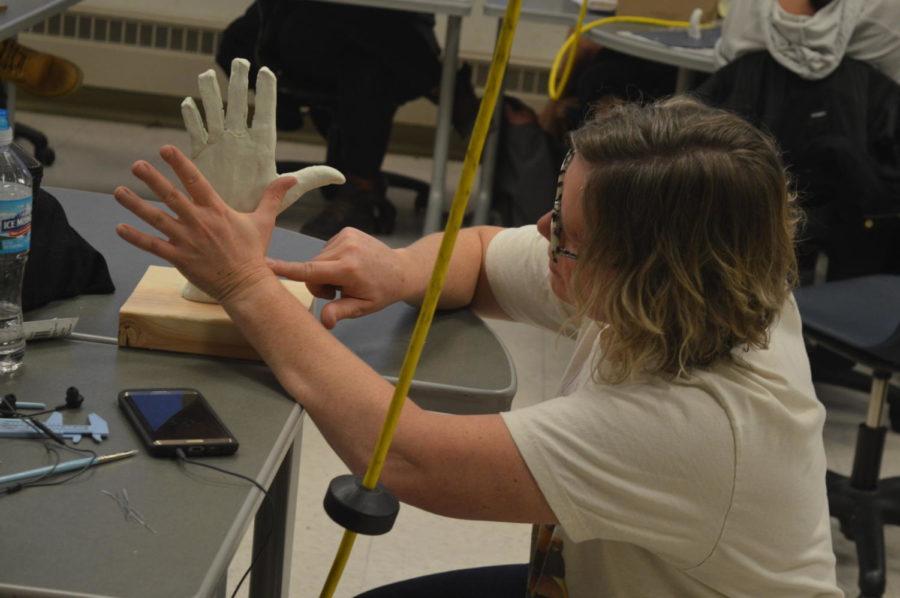BPMI: Program unites science and art
Jordyn DuBois/Iowa State Daily
Kim Moss an assistant professor in arts and visual culture shows students what to look for when sculpting a hand out of clay. The class has been working on sketches and measurements since late October and is now starting to bring the sketches to life.
November 5, 2018
Iowa State’s Biological Premedical Illustration (BPMI) program allows students to combine the intricate details of science and communication through art.
“[Students say] I love art and I love science,” said Lynn Clark, director of the BPMI program. “Now you can do both.”
During their first year, students in the program begin with general biology classes and labs, in addition to core design classes with studios. The intensive schedule sets the tone for the program right away.
After two years being pre-BPMI, students then prepare for a critique of their portfolio and submit it to be accepted into the program.
“The majority of students are accepted the first time, but some are told to improve and come back,” Clark said.
Kimberly Moss, coordinator of the BPMI program and professor of several BPMI classes, teaches classes in design like figure drawing, and many times uses pictures from Da Vinci as examples.
“[BPMI] goes back as early as Da Vinci…that was 600 BC,” Moss said.
Moss said the major encourages a “multi-directional way of thinking.”
Moss said through this way of thinking, it allows students’ minds to see things differently. Students will begin to see aspects of art in their science classes and science aspects in their art classes. This way of thinking builds their “toolbox.”
“Being able to use the toolbox is key….[as] a way of seeing and understanding,” Moss said.
She said technology opens up a whole new way for these students to use what they learn when expressing science through art.
Not only can students put pen to paper, but they can put stylus to tablet as well by creating works of art online.
“There are so many ways to combine the two [the traditional art and the digital art] but also you can just pick one” said Ava Schroedl, senior in the BPMI program and president of the BPMI club on campus.
Schroedl said when it comes to day to day work, students switch back and forth between science lectures, labs and design studios.
Both Clark and Moss listed possibilities of careers students can do after they graduate.
Many go to graduate school to get their masters as a medical illustrator, some go to medical school, while others get jobs right away.
Clark said students can get jobs in science textbook publishing, helping design exhibits and artwork for museums and even building face prosthetics for burn victims.
“[Students can] build ears for people who were born without them … there are so many options for students,” Clark said.
Clark said the program grew steadily until about 2012. In the last five years, the amount of students enrolled in the program has doubled.
She said she is not sure about why the program has grown so quickly in recent years, but it could possibly be the digital aspect.
Because the program offers so much more than just the traditional drawing and painting then it had before, more students are wanting to get be apart of the unique program, Clark said.
“Iowa State is one of only a handful of schools [in the country] with this program … it has been becoming more popular,” Clark said.
BPMI has become a destination major for Iowa State, which means people come from all over the country the world to study in this program, Clark said.
Schroedl came to Iowa State from Minnesota specifically for the BPMI program.
“When I typed into google Biological Illustration, it was [one of] the first things to pop up … it is a quality program with a good reputation,” Schroedl said.







